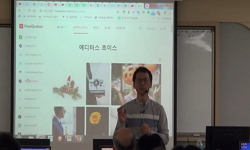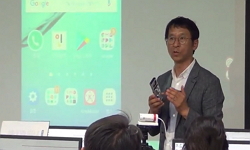유네스코(UNESCO)는 2019년 ‘2030 의제의 주제별 문화지표’(Thematic Indicators for Culture in the 2030 Agenda)를 발표하였다. 유네스코의 문화지표는 ‘지속 가능한 개발을 위한 국가 및 지역 구현에 대한...
http://chineseinput.net/에서 pinyin(병음)방식으로 중국어를 변환할 수 있습니다.
변환된 중국어를 복사하여 사용하시면 됩니다.
- 中文 을 입력하시려면 zhongwen을 입력하시고 space를누르시면됩니다.
- 北京 을 입력하시려면 beijing을 입력하시고 space를 누르시면 됩니다.

서원과 문화콘텐츠 : 한국서원의 현대적 활용방안 = Confucian Academies and Cultural Contents - Modern Utilization Plan
한글로보기https://www.riss.kr/link?id=A108766958
-
저자
방미영 (서경대학교)
- 발행기관
- 학술지명
- 권호사항
-
발행연도
2023
-
작성언어
Korean
-
주제어
세계유산 ; 향교 ; 서원 ; 문화유산 ; 문화콘텐츠 ; 관광체험 콘텐츠 ; Heritage ; Hyanggyo ; Seowon ; Cultural Heritage ; Cultural Contents ; Tourism Contents
-
등재정보
KCI등재
-
자료형태
학술저널
-
수록면
623-634(12쪽)
- DOI식별코드
- 제공처
-
0
상세조회 -
0
다운로드
부가정보
국문 초록 (Abstract)
유네스코(UNESCO)는 2019년 ‘2030 의제의 주제별 문화지표’(Thematic Indicators for Culture in the 2030 Agenda)를 발표하였다. 유네스코의 문화지표는 ‘지속 가능한 개발을 위한 국가 및 지역 구현에 대한 문화 활성화 기여의 진전을 측정하고 모니터링 하는 것’을 목표로 하는 주제 지표의 틀이다. 유네스코의 2030 문화지표는 단 한 사람도 소외되지 않는다는 유엔이 정한 17개의 지속가능발전목표(SDGs)와 169개 세부 목표와 맥락이 닿아 있다. 유엔이 정한 17개의 지속가능발전목표(SDGs)를 달성하기 위해서는 문화의 역할이 중요하면서도 문화 기여에 대한 지표가 존재하지 않다는 것이 유네스코가 문화지표를 개발하게 된 연유이기도 하다. 한국의 서원 또한 유엔이 정한 문화지표를 토대로 발전방안을 모색할 필요가 있다. 본 연구를 통해 필자는 한국의 서원의 현대적 활용 방안을 첫째, 9개 서원 통합브랜드 CI, BI 구축; 둘째, 통합브랜드를 통한 관광상품 개발; 셋째, 문화관광 효과를 위한 체험형 콘텐츠 개발; 넷째, 지역연계 관광프로그램 확대; 다섯째, 청년집단지성을 통한 홍보 및 컬쳐마케팅; 여섯째, 후속세대 연구자 배양을 위한 서원교지 제작; 일곱째, 세계유산 관련 전문가들로 구성된 운영체계를 구축 등 일곱 가지를 제안한다.
다국어 초록 (Multilingual Abstract)
UNESCO published‘Thematic Indicators for Culture in the 2030 Agenda’in 2019. UNESCO’s cultural indicators are a framework of thematic indicators that aim to‘measure and monitor progress in the contribution of cultural revitalization to nationa...
UNESCO published‘Thematic Indicators for Culture in the 2030 Agenda’in 2019. UNESCO’s cultural indicators are a framework of thematic indicators that aim to‘measure and monitor progress in the contribution of cultural revitalization to national and regional realization for sustainable development’. UNESCO's 2030 cultural indicators are in context with the 17 Sustainable Development Goals (SDGs) and 169 detailed goals set by the United Nations that no one is left behind. In order to achieve the 17 Sustainable Development Goals (SDGs) set by the UN, the role of culture is important, but the fact that there is no indicator for cultural contribution is also the reason why UNESCO developed cultural indicators. Confucian academies in Korea also need to seek development plans based on the cultural indicators set by the UN. A modern utilization plan for Seowon in Korea is proposed. Establish CI and BI of 9 Seowon integrated brands; develop tourism products through integrated brands; develop experiential contents for cultural tourism effects; Seven suggestions were made: expansion of regionally linked tourism programs; publicity and culture marketing through youth collective intelligence, sixth, production of Seowon textbooks for cultivating next-generation researchers, and seventh, establishment of an operating system composed of world heritage-related experts.
참고문헌 (Reference)
1 진성수, "전북지역 서원(書院)의 현대적 활용 방안" 원불교사상연구원 (70) : 263-294, 2016
2 "https://www.cha.go.kr/multiBbz/selectMultiBbzView.do?id=19907&no=26567&bbzId=newpublic&mn=NS_01_01"
3 "https://whc.unesco.org/en/culture2030indicators"
4 "Hague Convention of 1954 for the Protection of Cultural Property in the Event of Armed Conflict"
5 Bang MeeYoung, "Conservation of Seowon in Korea. Management and Utilization Implementation Plan" Korean Seowon Integrated Management and Preservation Group
6 Cultural Heritage Administration, "Comprehensive Plan for Preservation, Management and Utilization of World Heritage 2022~2026"
7 Kim Jungi, "A Study on the Development of a Confucian Modernization Program Using Hyanggyo Confucian Academy" 2013
8 Korean Seowon Integrated Management and Preservation Group, "2023~2027 Conservation of Seowon in Korea, Management and Utilization Implementation Plan"
1 진성수, "전북지역 서원(書院)의 현대적 활용 방안" 원불교사상연구원 (70) : 263-294, 2016
2 "https://www.cha.go.kr/multiBbz/selectMultiBbzView.do?id=19907&no=26567&bbzId=newpublic&mn=NS_01_01"
3 "https://whc.unesco.org/en/culture2030indicators"
4 "Hague Convention of 1954 for the Protection of Cultural Property in the Event of Armed Conflict"
5 Bang MeeYoung, "Conservation of Seowon in Korea. Management and Utilization Implementation Plan" Korean Seowon Integrated Management and Preservation Group
6 Cultural Heritage Administration, "Comprehensive Plan for Preservation, Management and Utilization of World Heritage 2022~2026"
7 Kim Jungi, "A Study on the Development of a Confucian Modernization Program Using Hyanggyo Confucian Academy" 2013
8 Korean Seowon Integrated Management and Preservation Group, "2023~2027 Conservation of Seowon in Korea, Management and Utilization Implementation Plan"
동일학술지(권/호) 다른 논문
-
TRIZ 활성화를 위한 HIDEA Algorithm 도입
- 사단법인 한국융합기술연구학회
- 김성복
- 2023
- KCI등재
-
- 사단법인 한국융합기술연구학회
- 양종현
- 2023
- KCI등재
-
- 사단법인 한국융합기술연구학회
- 신현중
- 2023
- KCI등재
-
2 kg 급 EOTS가 장착된 옥타콥터의 비행데이터 획득 및 주파수분석에 대한 연구
- 사단법인 한국융합기술연구학회
- 곽동기
- 2023
- KCI등재




 KCI
KCI






